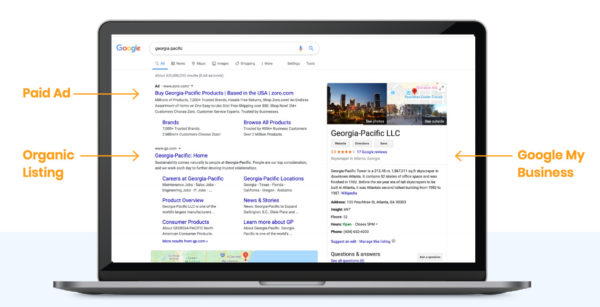
If you own, operate, or run a manufacturing company, there’s one thing you know for sure: your products are the best. You’re the one making them, after all. The thing is, even if you know you’re the best… how do you make sure everyone else does too?
There are a lot of ways. Yelling out your windows might work, but it won’t get you the quantity of leads you’re looking for. Offering demos for free on every social media post you see could get you clicks, but the leads won’t be very high quality.
Then there’s search engine optimization. Using search engine optimization, or SEO, can get you leads that are both high in quantity and high in quality. If you’re wondering how they can do that, you’re in the right place. We’ll answer that question – as well as explain what SEO is and why it works – below.
Ready to get new manufacturing deals and repeat business — all in one place?
What is SEO in simple terms?
Search engine optimization, in the simplest of terms, are efforts specially made to get your web pages to show up on organic web searches.

There are three main sub-varieties of search engine optimization (SEO): on-page, off-page, and technical.
- On-page SEO are the changes you make to your individual web pages to help them rank. These efforts most commonly revolve around the production and promotion of relevant, keyword-focused content (like blog posts) as well as writing effective meta descriptions, title tags, and h1s.
- Off-page SEO are the things that are happening on other websites to drive traffic than yours. This type of SEO relies most on links coming from outside your website, like those found on partner sites, affiliate posts, and social media posts.
- Technical SEO is, unsurprisingly, the most technical type of optimization. These efforts rely on knowledge of the different search engine algorithms and how to best work within and around those algorithms to get your pages to rank.
How do I make my manufacturing business show up better on Google?
You can make your business show up more on Google searches (and on other search engines as well) by using all three SEO sub-varieties in conjunction. Each of these subcategories has a number of techniques you can focus on in order to improve your B2B site’s SEO.
Important on-page SEO efforts include:
- Choosing target keywords for each page and making sure to use that keyword within the first 150 words of the page
- Using header tags whenever it’s possible and makes sense. This includes both headers (h1) and subheaders (h2).
- Not overstuffing your web pages with target keywords, but instead making an effort to use them more than just once on a designated page.
Important off-page SEO efforts include:
- Making a concentrated effort on reputation management by managing reviews and creating positive social media interactions
- Creating a product that’s the best in the industry, making positive word-of-mouth a reliable marketing effort
- Providing above and beyond customer service
- Critically thinking about the intentions of anyone searching for your product or business and creating content that meets those needs
Important technical SEO efforts include:
- Making sure the structure of your website makes it easy to navigate so searchers can find what they’re looking for without trouble
- Having fast load times on your individual web pages
- Making sure your website performs just as well on mobile platforms as it does on desktop ones
What are the best keywords to use for my business?
Knowing where to include your keywords is one thing, but actually choosing the right ones is another thing altogether. One thing’s for sure: never settle for just choosing keywords at random. Instead, follow these five simple steps for creating a quality SEO keywords starter list.
- First, think about your audience. Ask yourself who you are trying to reach and then think about how they would search for your product. Write down details about this imaginary business you’re working with. Consider what’s important to them, what they want, and how quickly they want it.
- Create keyword categories. This will be a list of high level topics that can be driven down to more specific keyword categories. Think about phrases that represent your business and what it can offer to the buyer in the first step.
- Brainstorm different keywords that fall beneath each of your topics. Start with as big a brain dump as possible. Get individuals from different parts of your company to add to the list.
- Use a keyword tool to determine which of the keywords on your first list are most viable. There’s a Keyword Planner tool available within the Google Ads interface that many companies use for this step.
- Using your list and the data you got, create a priority list. Keywords that you consider most relevant and have decent search volume will be priority 1, with less relevant keywords having a priority of 2 or 3. Now you have a list of phrases to start building content around!
This is all you need to know to get started with SEO for your manufacturing company. To dig further into using search engine optimization and other digital marketing tactics to boost your business, I recommend checking out The Download.
It’s Constant Contact’s guide to everything you need to know about marketing your manufacturing business – all in one understandable, easy-to-follow package.




